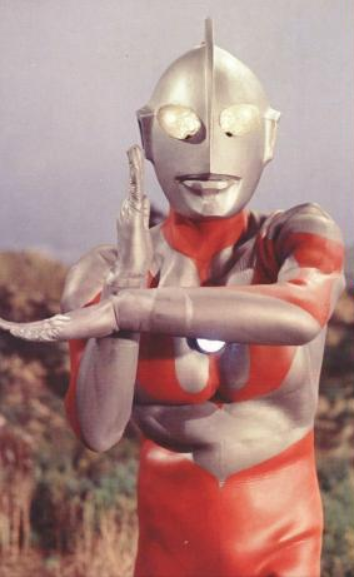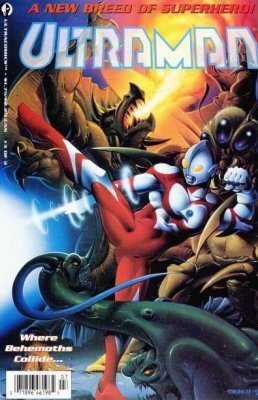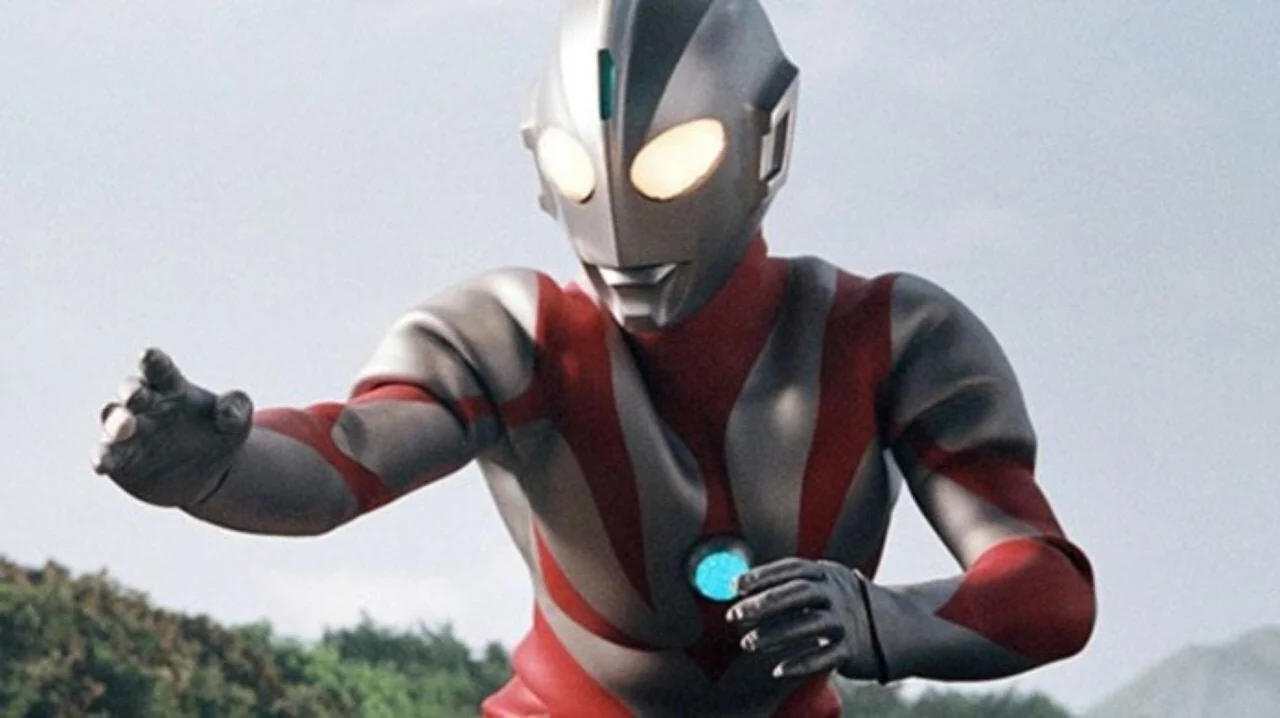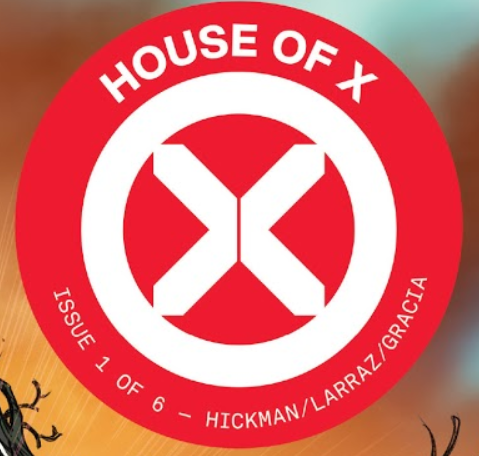009: The Legacy of Ultraman
This entry is the first of many relating to one of my favorite Japanese creations, the giant alien superhero Ultraman! One of the most enduring and familiar Japanese super heroes of all time is Ultraman. You've likely seen him here and there without even knowing who he is. His most common design is a red and silver body suit, a crystal in his chest, a head that comes to a sort of fin, and alien-esque features.
Strike a pose. (Credit: Tsuburaya Productions)
This will be an overview post going over some of the history of the Ultra series and the impact it's had on pop culture. This will not be a complete picture, but I'll do what I can. There's way too much to cover in one post. (Which is why I plan to do several.) My next post in this line will be about the very first installment Ultra Q, which I'll touch on briefly later.
Flashy. (Credit: Ultracomics)
I like to start these overview posts by talking about my personal history with the subject. I first discovered Ultraman as a teenager. I was getting into Godzilla majorly around the time, watching (and recording) every movie that came on satellite. One day I was at my local comic book store, hunting for Spider-man comics, and I noticed an Ultraman comic book. (The one pictured above.) Something about it caught my eye amid all the holographic covers and variants. It was glossy, yet simple. It was action packed and had interesting monster designs. It was like Godzilla, but the monsters were battled by a giant super hero. This concept intrigued me. I bought it, but was unable to find other issues. I wanted to know more. This was before the internet was the common resource it is now, so I had trouble finding much information about Ultraman. The little research I managed to do told me that it was a television series in Japan. I vowed to someday watch it. It took me several decades before this vow came to be.
Fast forward to a few years ago. I was snatching up every Godzilla movie I could find on DVD and I remembered Ultraman. I found a full series collection on eBay and ordered it as quickly as I could. When it arrived I watched the first episode and enjoyed it. I then got distracted by other things for a few years. (Which NEVER happens to me.) After moving into our house, I had finished my journey through every Godzilla movie in order and the Toei Spider-man series. I was missing my Saturday night Japan-fueled entertainment. That was when I remembered I had every episode of Ultraman. I sat down on the couch with a few beers and immersed myself in a new world.
There are a couple of things about me that are certain. When I love something, I love it with an all-encompassing devotion. The other thing is that I gravitate towards entertainment that has a wealth of content. If I see a TV show with several seasons or a film or video game series with lots of sequels, I'm more likely to give it a try.
Zap. (Credit: Tsuburaya Productions)
When I (finally) got fully into Ultraman I did some research on it and was amazed to discover that it did not end with this 39 episode series. It was actually a sequel. The first series, Ultra Q, was an anthology that had no relation to the rest of it. And beyond that, there were many later shows and movies in the Ultra series. I had no idea it was so extensive, and I was thrilled by this newfound knowledge. Unfortunately a lot of that content is not conveniently accessible. Especially to someone who keeps procrastinating on learning Japanese. Oh well, I decided that I would watch as many as I could. And then learn Japanese so I could watch the rest.
I did a casual (translation: slow) watch of the entire 1966 series. It was a lot of fun and I was pretty sad when it was over. However, by the time I finished, I'd purchased the next two series, so I was excited to embark on the next leg of the journey. The next one up is Ultra Seven. I only got a few episodes into it before getting distracted again (always wandering off after new and shinier things) but so far it's just as much fun as the first one. My only problem is that I got attached to the old characters and now I have to get acquainted with a new cast of characters. I know they'll grow on me after a few episodes. Doing these posts will help give me some incentive to continue on with the journey.
My collection so far.
Ultraman is a tokusatsu series from Japan that has gone on for 5 decades, beginning in 1966 and continuing on to this day. Tokusatsu translates to "special filming" and is a style of film that relies heavily on special effects. It utilizes things such as forced perspective, miniatures, and men in elaborate suits to get the special effects across.
Ultraman was created by Eiji Tsuburaya, who was head of special effects at Toho, the studio that brought us Godzilla, Mothra, and more. Helping him along was writer Tetsuo Kinjo and designers Tohl Narita and Akira Sasaki. The designs and conception were a group effort, taking several drafts and alterations before it settled on the form it is in now.
Over the decades, a rich lore has emerged, although each series is a new story and only loosely connected to the whole. After a time it was revealed that there is actually a multiverse made up of "bubble universes". So each series takes place in one of these universes. This allows the different series to all be considered canon while not always being directly related. Some of the Ultramen have the ability to travel between universes. As time has gone on, many Ultramen have crossed over to meet others.
What a happy monkey. (Credit: Tsuburaya Productions)
The entire saga began with a show called Ultra Q. I'm working on a post for that one while I'm watching it, so I won't get too in depth into it here. Due to the popularity of that show, they went ahead and did a sequel series, which is where the first Ultraman was introduced. This one was the result of several story concepts that eventually evolved into the Ultraman we now know. The third series, Ultra Seven, was meant to end the series, but years later they came back with The Return of Ultraman, and have been going strong ever since.
The Ultramen are a race of advanced beings from a distant galaxy. They are powered by solar energy. Due to the pollution and light filtering on Earth's atmosphere, Ultramen can only live for a limited time on Earth. They have color timers that flash rapidly when their energy is almost depleted. Because of this, they have to merge with humans in order to survive, only transforming when their services are needed to defeat evil in its myriad of forms.
The various Ultramen have starred in television, movies, anime, comic books, and video games. In the core canon there have been 36 series and 28 movies. (4 of those series and several movies are clip shows, though.) For the most part, the individual series are separate with different characters and stories. Occasionally previous Ultramen and monsters will appear, however. One of the most common connecting threads is a high ranking Ultraman named Zoffy. From what I've seen, Zoffy is basically a supervisor or manager, which the others report to.
"I'm HUGE!" (Credit: Tsuburaya Productions)
Now bear in mind that as of the writing of this I have only watched Ultraman, a few episodes of Ultra Seven, and I am maybe a quarter of the way through Ultra Q. So I'm by no means an expert yet. I'm not sure of the tone and quality of the later series. From what I've experienced so far, the shows combine the genres of action, adventure, science fiction, horror, comedy, and super heroes. It's an interesting combination, making for an entertaining experience unlike anything else I’ve seen. The characters are likable, there's enough humor to keep things from getting too dark, but there are dark elements. Some of it is a tad formulaic, but there's enough variety to keep it from getting predictable. The monster battles can be pretty intense and bloody.
The dreaded Bemular! (Credit: Tsuburaya Productions)
There have been many Kaiju and aliens in the course of the Ultra Series. Some of them look very familiar to fans of Toho films. The reason for this was that Toho allowed Tsuburaya to access their prop department. To create the monsters for his shows, Tsuburaya Productions altered the costumes from old films, creating new monsters. Most notable among these recycled Kaiju were old Godzilla suits, and King Kong from King Kong Vs Godzilla.
The monsters vary in origin. Some are naturally occurring, some are mutated due to some disaster or scientific interference. And others are extraterrestrial in nature. Aliens are recurring antagonists in Ultraman. Some recurring alien races are the Baltan and the Zetton. Some Kaiju return from one series to another, as well.
Same, Arashi. Same. (Credit: Tsuburaya Productions)
There is an underlying campiness to Ultraman, but there is also a seriousness to it. The show has morals, lessons, and character development. While sometimes the monsters look silly, you can tell there was a lot of care put into their design, and in the context of the stories, they are very real threats. You never know where the show is going to go next and what danger will face our heroes. Humankind is at risk, and the only things that can save the Earth are Ultraman and his friends.
One of the fun things about Ultraman is that he's not wildly overpowered. He gets his ass kicked sometimes. He has to use strategy to defeat his enemies. He knows when to use his special techniques, and when to get in close to wrestle his way to victory. Especially due to the limitation of his color timer. If he expends too much energy or takes too long to defeat his foe, he will die. Still, he's willing to take any risk. He has a strong sense of justice and will do anything to protect those in need.
So shiny. (Credit: Tsuburaya Productions)
Ultraman has had an impact on pop culture, although you may not realize it. Without Ultraman, there would be no Power Rangers, and all the different variations and knock offs of them. In 1975 a show premiered by Toei called Super Sentai, which took many inspirations from the formula of Ultraman. Super Sentai was also inspired by Kamen Rider, which itself drew from Ultraman. Super Sentai continues to this day, and was the precursor to Power Rangers. Ultraman has inspired many other creations as well. Ant-Man's costume design in the Marvel Cinematic Universe was also said to be inspired by Ultraman.
The noble hero of Japan. (Credit: Yudetamago)
Another work that drew heavily from Ultraman was a comedy manga that began in 1979 called Kinnikuman. (This translates into English as "Muscle Man".) Those in America may know this property as M.U.S.C.L.E., a popular toy line in the 80s that consisted of tiny pink (and later multi-colored) plastic figurines with a wrestling theme. (I still have dozens of those things.) It was created by Yoshinori Nakai and Takashi Shimada as a tribute to and parody of Ultraman. Kinnikuman was a prince from a distant world who was stranded on Earth and yearned to be the hero of Japan. Unfortunately for him, he was a bumbling fool, greedy, gluttonous, and arrogant. He powered up by eating garlic and one of his signature moves was the Kinniku Flash, which was patterned after Ultraman's Specium Ray. (The finishing move Ultraman does when he crosses his arms.) Although the manga began as a super hero parody, it eventually evolved into a wrestling manga with a huge cast of characters. Kinnikuman is a juvenile but entertaining manga, and it's one that I'm casually working my way through, reading translations online. (I'm currently on Issue 32.)
Bargain Bin Ultra. (Credit: Toho)
1973’s Godzilla vs. Megalon involved a size-changing robot character named Jet Jaguar. (Shown above.) The character and look of Jet Jaguar was obviously derived from Ultraman, even down to his ability to fly and his propensity for dramatic posing.
Sleek and modern. (Credit: Netflix)
I have yet to watch the new Netflix anime series, but it's in my queue. It looks good, but beyond that, I feel like this is a positive step for the Ultra series. Because the big U is becoming more mainstream, hopefully we'll get better access to the Ultra series. Already there are new Blu-ray sets being released for the first four series. (Including Ultra Q, so I didn't have to spend a huge amount of money obtaining it!) If those sell well enough and interest continues to grow, maybe we'll get Ultra Ace (the 5th series) re-released and the subsequent entries.
Also recently it was announced that a new movie would be made in Japan called Shin Ultraman. (Shin translates to "new" in English.) The movie is in good hands, because it's going to be directed by Hideaki Anno, the creator of Neon Genesis Evangelion. Another great announcement this month (one you may have seen on the SoraRabbit Facebook ) was a deal between Tsuburaya Productions and Marvel to create new Ultraman comic books. Whether that means he's going to officially be a part of the Marvel Universe remains to be seen, but I would very much enjoy seeing him team up with Spidey. Even if he's separate from the mainline Marvel Universe, I'm still expecting the comic to be fun.
So all in all, the Ultra future looks very bright.
Behind you Ultraman! (Credit: Tsuburaya Productions)
As of the writing of this post, I have the first four series and the Netflix anime to get through. All in all there are 994 episodes (and counting!) across the entire Ultra series, so getting through them all will take some time. (I'm not counting the 311 episodes of the four biography series, because those are clip shows with no original content.) I intend to watch all 994 and would like to take you all through that voyage with me. That makes you honorary members of the Scientific Special Search Party, so count yourselves among greatness.
Zap times three. (Credit: Tsuburaya Productions)
Thank you for reading the first in my Ultra series of posts. I hope you found this informative and will check out Ultraman and the other installments. It's certainly worth the time. I'll be back soon with more treasures to explore!




















